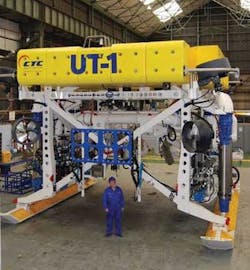Trenching vehicles tackle pipelay in sand, hard ground
Julian Steward, Fiona Duckworth - CTC Marine Projects
CTC Marine Projects, a UK-based subsidiary of DeepOcean ASA, has introduced two new trenching vehicles for pipelay in problematic soils.
The UT-1 Ultra Trencher is a jet trenching ROV capable of trenching pipelines up to 1 m (3.28 ft) OD in soils not previously considered jettable. The system can deliver 1.5MW of jetting power to enable the trenching of rigid products in all uncemented sands and clays up to 100 kPa. It thereby provides twice as much controllable power as any existing jet-trenching ROV.
For the UT-1 design program, CTC performed research with Fugro, Cathie Associates, and the University of Taiwan to establish the fundamental principles of jetting rigid products in sand and to determine methods of controlling and maximizing pipeline depth of lowering.
The research established that maintaining the fluidized trench behind the vehicle is critical. The team also concluded that maximizing seabed fluidization at the front of the trench, then maintaining this fluid state as far as possible behind the trencher, provided the most effective means of lowering the pipeline below the seabed.
Taking these results into account, UT-1 was designed with a multiple jet sword and nozzle configuration to produce forward-facing jets with very high flow rates. In operation, the jetting swords also can oscillate to effectively undercut the seabed beneath a large diameter pipe. Aft jetting swords inject additional water at the rear of the vehicle to maintain fluidization in front of the pipeline.
Subsea-adjustable, variable trench width control accommodates joints, anodes, end fittings, and related subsea architecture without need for an over-wide trench. An optimum trench configuration at any trench depth is achieved by the constant vertical orientation of the jetting swords between 0.75-2.5 m (2.46-8.2 ft), minimizing pipe stress on lowering.
The newbuild support vesselVolantis and a specialized handling system have been designed around UT-1 to provide maximum operational capability in severe weather. The A-frame based launch and recovery system includes a submersible latch beam, cursor, and high speed (3 m/s [10 fps]) constant tension recovery winches. Severe weather deployment and operation (targeted at Hsig≤ 5 m, seastate 7) should facilitate year-round operability.
Breaking through tough soil
CTC’s RT-1 Rock Trencher is designed to address issues of protecting and/or stabilizing large diameter rigid pipelines in hard ground where jetting or ploughing are not feasible.
The vehicle uses three cutters arranged in a unique, diagonal configuration to allow the entire trench face to be attacked in a single pass. It also enables removal of soil from underneath the pipe, which is critical to performance in layered or fractured soil. The forward dredge system removes the “as cut” spoil to minimize any re-circulation. A rear dredge system removes spoil from the completed trench.
Trunklines frequently have to be laid in a flooded (and therefore heavy) configuration to ensure they are stable when positioned on the seabed – to offer protection, for example, from the effects of cyclonic activity.
Pipe stress analysis indicates that a lifting system with a “V” configuration minimizes pipe lift to limit stress in the flooded condition. RT-1 incorporates triple rollers at the front and rear to support the pipe. This enables accommodation of filled and unfilled joints and piggy-back lines.
Two successful field trials have been conducted with a 40% scale model to prove the cutting technology in soil conditions representative of those in hard ground regions such as the arctic, the Northwest Australian shelf, and the Shetlands. The base vehicle was scheduled to undergo sea trials this spring in the North Sea.



